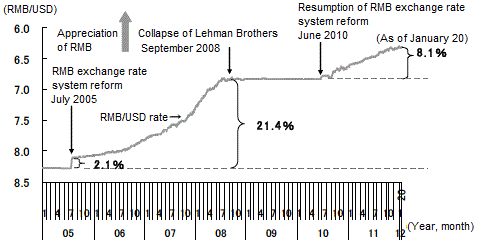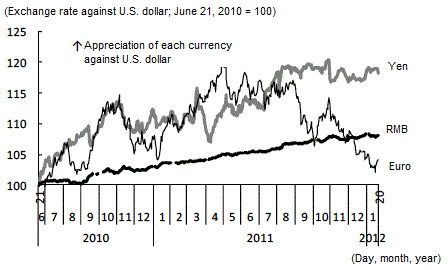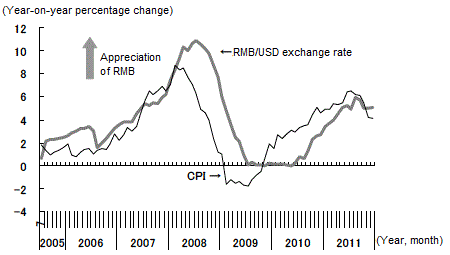RMB rate remains under strict control
In a bid to improve the independence of monetary policy and ease trade friction with the United States, China has been working on the renminbi (RMB) exchange rate system reform. In July 2005, China revalued the RMB against the U.S. dollar by 2.1% and shifted from the de facto U.S. dollar peg to the managed floating exchange rate regime. Although it temporarily revived the U.S. dollar peg as an emergency measure implemented subsequent to Lehman Brother's collapse in September 2008, China effectively returned to the managed floating exchange rate regime in June 2010, and the exchange rate policy has remained unchanged to this day (Figure 1).
Figure 1: Changes in the RMB/USD exchange rate

Source: Created by Nomura Institute of Capital Markets Research based on data provided by the State Administration of Foreign Exchange of China
However, even after shifting to the managed floating exchange rate regime, the People's Bank of China (PBC) has been intervening on a daily basis in the foreign exchange market to buy U.S. dollars against the RMB to tame the latter's rise. Reflecting this, China's foreign reserves are continuing to increase, reaching $3.1811 trillion as of the end of 2011. Increasing liquidity as a result of foreign exchange interventions has been causing a rise in inflationary pressure. In order to prevent this, the central bank must refrain from intervening in the foreign exchange market, and it should instead allow the RMB to appreciate more rapidly.
Meanwhile, in the face of a massive trade deficit with China, the United States is pointing to unjustified exchange rate manipulations by China as the cause of the imbalance. In its Semiannual Report to Congress on International Economic and Exchange Rate Policies presented in December 2011, the U.S. Department of the Treasury did not go so far as to call China a "foreign exchange manipulator," probably out of concern over a potential negative impact on the U.S.-China relationship and effects on the financial markets. However, the report makes complaints that the appreciation of the RMB to date is insufficient and pressed for policy changes to allow greater exchange rate flexibility.
Managed floating exchange rate regime under the BBC regime
The managed floating exchange rate regime--which was initially introduced in July 2005 and then, after a temporary halting, was resumed in June 2010--can be described as a BBC regime that combines band, currency basket, and crawling ("crawling" means exchange rate adjustment in a certain direction).
Under this system, the Chinese monetary authority announces the central parity rate of the RMB against the U.S. dollar each business day prior to the opening of trading and limits currency fluctuations within a certain range around it. The float range for the RMB exchange rate against the U.S. dollar was initially set at 0.3% above and below the central parity rate but has been raised to 0.5% since May 21, 2007. The PBC has been intervening in the foreign exchange market daily to keep the RMB exchange rate against the U.S. dollar within this range.
Meanwhile, when adjusting the RMB exchange rate against the U.S. dollar with reference to a currency basket, ensuring the stability of the RMB/U.S. dollar exchange rate is the primary focus, but the monetary authority also takes into consideration changes in the exchange rates of the currencies of China's major trade partners against the U.S. dollar. Through this, China seeks to stabilize the effective exchange rate of the RMB. The weights of the component currencies are not disclosed. However, it is believed that the U.S. dollar accounts for the majority share as there is little correlation between the RMB's exchange rate against the U.S. dollar and that of other major currencies (Figure 2).
Figure 2: Changes in the exchange rates of the RMB, euro, and yen against the U.S. dollar

Source: Created by Nomura Institute of Capital Markets Research based on data provided by the State Administration of Foreign Exchange and Bloomberg.
Regarding the pace of crawling, the RMB (central parity) has appreciated 31.1% against the U.S. dollar since the July 2005 shift from the U.S. dollar peg to the managed floating exchange rate regime. However, the pace of appreciation varies significantly at different points in time, even excluding the two years or so during which the U.S. dollar peg was revived. This reflects the fact that the exchange rate of the RMB against the U.S. dollar is being adjusted by the Chinese government, taking into consideration the economic conditions of the time, rather than being determined by changes in the supply-demand balance in the market.
Foreign exchange rate policy as a tool to stabilize prices
In setting the central parity rate of the RMB and the pace of crawling, the Chinese monetary authority seems to be giving the greatest priority to price movements. More specifically, the monetary authority accelerates the RMB's appreciation against the U.S. dollar when the inflation rate is on the rise, and slows down the pace of appreciation as inflation cools down (*).
When we compare the rate of RMB appreciation against the U.S. dollar and the inflation rate measured by CPI (both on a year-on-year basis) from July 2005 onward, we can see the strong tendency of the RMB appreciation rate to track the inflation rate. This seems to contradict the market principle, which suggests that higher inflation should lead to a weaker currency, and reflects the government's intention to stabilize prices by controlling exchange rate fluctuations (Figure 3).
Figure 3: RMB appreciation rate against the U.S. dollar moving in tandem with the inflation rate

Note: RMB/USD exchange rate is the monthly average.
Source: Compiled by the Nomura Institute of Capital Markets Research based on data provided by the State Administration of Foreign Exchange of China.
After peaking at 6.5% in July 2011, China's inflation rate declined to 4.1% in December 2011. In tandem with this, the RMB appreciation rate against the U.S. dollar (year-on-year, monthly average) peaked at 5.9% in August 2011 and declined to 5.1 % in December 2011. As the downward trend of the inflation rate is expected to continue for some time, the pace of RMB appreciation against the U.S. dollar will likely slow down further.
Future prospect for the RMB reform
As such, under the current managed floating exchange rate regime, the monetary authority has an extremely strong influence on the RMB exchange rate. The RMB exchange rate remains subject to "management" by the monetary authority rather than "fluctuations" reflecting changes in the supply-demand balance in the market. The monetary authority intends to expand the RMB exchange rate flexibility. Speaking of the next step forward in an interview with China Central Television (CCTV) broadcasted on January 9, 2012, PBC Governor Zhou Xiaochuan said that the central bank "would not mind widening the RMB exchange rate band further," suggesting readiness to allow the RMB to move beyond the current limit of 0.5% above or below the central parity rate per trading day.
However, widening the exchange rate band does not necessarily bring the RMB exchange rate more in line with the supply-demand balance in the market, because the monetary authority can set the level of exchange rate and the pace of crawling in accordance with its policy objectives so long as it announces the central parity rate of the RMB each trading day and continues to intervene in the foreign exchange market. Shifting to a full-fledged floating exchange rate system involves stopping the practice of announcing the central parity rate and easing the management of the RMB exchange rate by refraining from intervening in the foreign exchange market. With a roadmap toward that goal yet to be presented, the shift to a full-fledged floating exchange rate will likely remain a challenge to be tackled over a medium- to long-term period.


